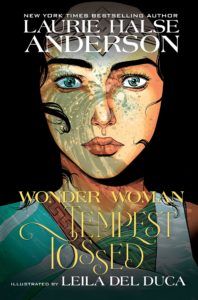I started reading comics after my son was born (I’ve written about that here), and Wonder Woman was one of the ones I read religiously. By the time the movie came out, I was well-versed in her comic history, different runs, her origin stories, and my opinions on art and storyline. When I saw the movie, it was just what I needed at that moment in time. The first two years or so of motherhood were very, very hard for me. I was a single mother, and though I knew going into it that it would be hard, it was a million times harder than I expected. My son didn’t sleep—I didn’t get more than three continuous hours of sleep for nearly three years. He had some developmental delays and language issues, which made childcare not an option, and he required various doctor’s appointments. At one point, he had six therapy sessions a week through Early Intervention. Through it all, I worked full-time and then some. Reading and watching Wonder Woman were escapes. Seeing Diana walk across that battlefield with her shield, deflecting the bullets with her wristbands, that look on her face—pure strength, bravery, and power. It’s also a reminder that somewhere, though I didn’t feel like it, I had some strength, too. Ironically, as things have gotten easier (a little) with parenting, I haven’t been reading as many comics. This wasn’t a conscious choice, and whenever a graphic novel or memoir, or trade paperback comes in the mail that looks interesting, I happily read it. Lately I’ve been purposefully choosing to get back into comics reading, ordering some trades I’ve fallen behind on and picking up some graphic novels.
I had fallen out of touch with Diana and her adventures, but when I heard Laurie Halse Anderson was writing a graphic novel about a young Diana Prince, I knew I had to read it. I read Wonder Woman: Tempest Tossed (coming out June 2) last week, and it was the perfect book to mark my return to reading Wonder Woman. It is a new kind of origin story, set in the present day with a 16-year-old Diana. She finds herself in America and is faced with learning about income inequality, racism, refugees, and trafficking. It is a smart commentary on our politics and community today, and we even get a new look at Themyscira and Diana’s early life on the island. But for me, it was also about learning to see the strength inside, working through doubts, and making peace with oneself. We see Diana feel like she belongs nowhere and become frustrated with her perceived shortcomings. But we also see her create a makeshift family of her own, pursue justice and work toward social justice about which she is passionate, and forge her own way. We see Diana feel broken and alone, and then see how she builds herself back up. The book reminded me of how much I loved the character of Diana, and especially with the movie WW84 coming out this summer, it got me even more excited for the film. Anderson really captured the passion Diana has to make the world a better place, the care she has for the most vulnerable among us, and how she galvanizes people around her to make a difference and care about issues. But she was also able to capture the vulnerable parts of Diana, the parts we don’t often see—which was a nice balance. Reading it also reminded me how much I missed comics and graphic novels. Going from devouring several trades a week to only a handful a year is a big difference. I’ve missed that. I’ve missed losing myself in the artwork, or the admiration I have when I realize that the artist and the illustrator have managed to move the story forward in major ways in only a few panels. For me, reading books and reading comics can be very different experiences, and I’m not sure I realized what I was missing until I read Tempest Tossed. Want to read more Wonder Woman posts? Check out some more Diana Prince goodness here, here, and here.
